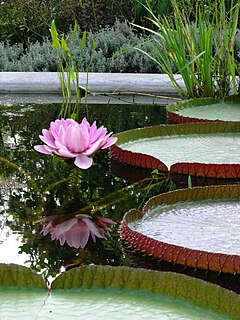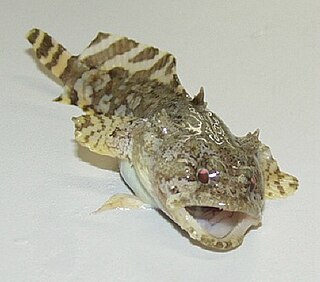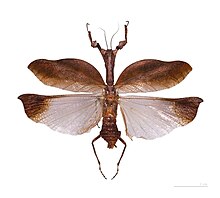
Victoria is a genus of water-lilies, in the plant family Nymphaeaceae, with very large green leaves that lie flat on the water's surface. Victoria amazonica has a leaf that is up to 3 metres (9.8 ft) in diameter, on a stalk up to 8 metres (26 ft) in length. The genus name was given in honour of Queen Victoria of the United Kingdom.

Batrachoididae is the only family in the ray-finned fish order Batrachoidiformes. Members of this family are usually called toadfish, or "frogfish": both the English common name and scientific name refer to their toad-like appearance.

Alocasia is a genus of broad-leaved, rhizomatous, or tuberous perennial flowering plants from the family Araceae. There are 97 accepted species native to tropical and subtropical Asia and Eastern Australia. Around the world, many growers widely cultivate a range of hybrids and cultivars.

Victoria amazonica is a species of flowering plant, the largest of the water lily family Nymphaeaceae. It is the national flower of Guyana. Its native regions are Guyana and tropical South America.

The orange-winged amazon, also known locally as orange-winged parrot and loro guaro, is a large amazon parrot. It is a resident breeding bird in tropical South America, from Colombia, Trinidad and Tobago south to Peru, Bolivia and central Brazil. Its habitat is forest and semi-open country. Although common, it is persecuted as an agricultural pest and by capture for the pet trade. It is also hunted as a food source. Introduced breeding populations have been reported in Puerto Rico and Tenerife in the Canary Islands.

Eucharis is a genus of about 15–20 species of neotropical plants in the Amaryllis family, native to Central America and South America, from Guatemala south to Bolivia. Some species have become naturalized in Mexico, the West Indies, and scattered tropical islands. The English name Amazon lily is sometimes used for all species in the genus, but is particularly used for Eucharis amazonica and Eucharis × grandiflora, which are often confused.
Dekeyseria is a genus of suckermouth armored catfishes native to tropical South America.
Ficus amazonica is a species of flowering plant in the family Moraceae. It is found in Brazil, Guyana, Trinidad and Tobago, and Venezuela.

The Purús red howler is a species of howler monkey native to Brazil, Peru and north of Bolivia.
Neischnocolus is a genus of spiders in the family Theraphosidae. It was first described in 1925 by Petrunkevitch. The genus Ami was separately described in 2008, but was later discovered to be a junior synonym of Neischnocolus. Species are native to Central America and northern South America.

Acanthopidae is a family of mantises consisting of 16 genera in the order Mantodea. The group was first formally split off as a separate family by the German entomologist Reinhard Ehrmann in 2002. In 2016, five genera were moved from Acanthopidae to the newly created family Acontistidae, but this has not been accepted in most recent classifications.

The National Botanic Garden of Bangladesh and the Bangladesh National Herbarium make up the largest plant conservation center in Bangladesh, with an area of around 84 hectares. It is located at Mirpur-2 in Dhaka,1100, beside the Dhaka Zoo. It was established in 1961. It is one of the greatest botanic gardens of Bangladesh, a knowledge center for nature lovers and botanists and a tourist destination. The herbarium has a scientific collection of approximately 100,000 preserved specimens of plants.

Ranitomeya amazonica is a poison dart frog in the genus Ranitomeya. It was first described by Rainer Schulte in 1999 as Dendrobates amazonicus when he separated it from Dendrobates ventrimaculatus, primarily on the basis of call characteristics. The validity of the species has been debated, but further studies, also including genetic data, support its validity.

Ilisha is a genus of ray-finned fishes in the family Pristigasteridae. The genus contains 16 species. It is similar to Pellona but lacks a toothed hypo-maxilla. The genus has a worldwide distribution in tropical and subtropical coastal waters and estuaries. Some species also enter rivers, and I. amazonica and I. novacula are largely–if not entirely–restricted to tropical rivers.

The Living Rainforest is an indoor greenhouse tropical rainforest located in Hampstead Norreys in Berkshire, England. It is an ecological centre, educational centre and visitor attraction consisting of three glasshouses, operated and run by the Trust for Sustainable Living. The glasshouses are named Amazonica, Lowlands and Small Islands respectively.
Metilia boliviana is a species of mantis of the family Acanthopidae.

Metilia brunnerii is a species of mantis of the family Acanthopidae.

The Rio Madeira stipplethroat, also called Madeira stipple-throated antwren, Madeira antwren or Rio Madeira antwren, is a species of bird in the family Thamnophilidae found in Brazil and Bolivia. Until 2014, it was considered a subspecies of the rufous-backed stipplethroat. The Rio Madeira stipplethroat has two subspecies:
Epictia amazonica, also known as the South American blind snake, is a species of snake in the family Leptotyphlopidae. It is found in South America.













